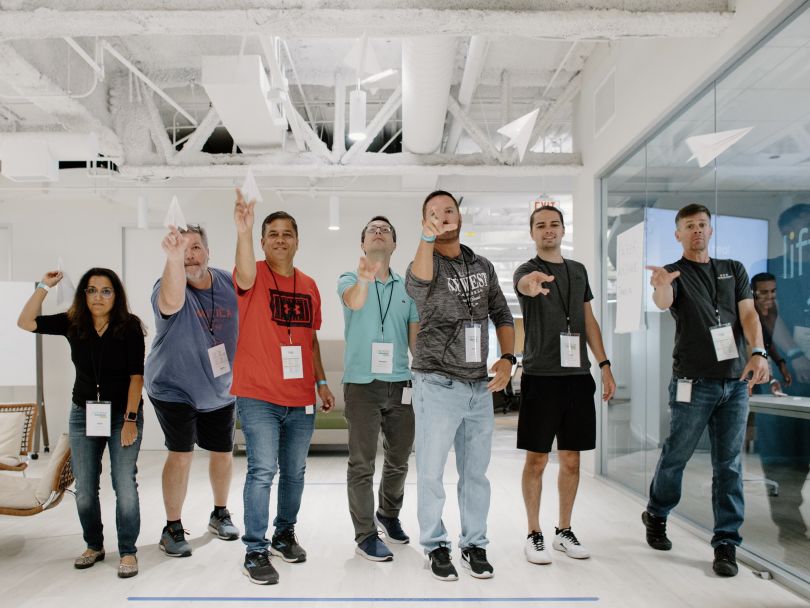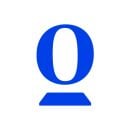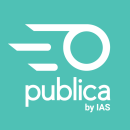Imagine a bicycle.
For the bicycle to move forward and function properly, both the pedals and the chain need to work together. If the pedals are working but the chain is broken, the bicycle won’t move. If the chain is intact but the pedals aren’t being pushed, the bicycle remains stationary.
Much like the forward motion of a bicycle, an exceptional user experience requires effective collaboration. Although UX design and engineering are distinct roles, a designer often initiates a product concept, while engineering brings it to life.
By working in harmony, they can create a seamless, functional and enjoyable user experience. Recently, UX designers shared insights into how their team collaborates with the engineering team and offered advice for other teams looking to strengthen their partnership.
EXAMPLE: BUILDING A MOBILE APP
- UX Design: Designers create user personas, wireframes and interactive prototypes for the app, focusing on how users will interact with it and what features are most important.
- Engineering: Engineers develop the app, writing code to implement the design and ensuring it works smoothly on different devices and meets performance standards.
- Testing and Refinement: Both teams test the app with real users, gather feedback and make necessary adjustments to improve the user experience.
JPMorgan Chase & Co. is a leader in investment banking, financial services for consumers and small businesses, commercial banking, financial transaction processing and asset management.
How does your team maintain a strong partnership with your company’s engineers, and why is this essential for the product development process?
My design team operates as a “quad” structure — integrating product, tech, design and data. Together, we build digital tools for wealth management advisors. To keep our partnerships effective, we prioritize regular, informal check-ins alongside structured sprints. This hybrid approach allows us to address minor hiccups before they evolve into roadblocks and ensure that the experiences we design for customers meet our strategic goals and are technologically sound and innovative.
Why we do this is simple: It enables us to innovate responsibly. Engineers bring a practical perspective to our creative ambitions, helping us scale the experiences we design sustainably. By understanding the tech constraints and capabilities, we can design experiences that not only meet immediate advisors’ needs but can be truly transformative, enhancing both advisor efficiency and client satisfaction.
How does your team balance the needs of UX designers and engineers?
It’s less about compromise and more about synergy. As UXers, we dive into the tech world deep enough to better understand tech constraints and use them as design parameters instead of seeing them as barriers. Engineers, on the other hand, develop a better grasp on user empathy, learning to see beyond the code to the human experiences that our designs aim to improve. This cross-pollination of skills is mutually enriching and it leads to innovations that are both user centric and technically sound.
KRUTCHINSKY SAID UX DESIGNERS INTERESTED IN STRENGTHENING THEIR TEAM’S PARTNERSHIP WITH ENGINEERING SHOULD:
- Cultivate a foundation of “technical empathy” by understanding the basics of engineering and appreciating their challenges and constraints without needing to become expert engineers themselves.
- Foster open, two-way communication where feedback is valued from both engineering and design perspectives.
- Keep the focus on the customer and end user throughout the product development process.
- Establish regular brainstorming sessions where technical and design perspectives converge to generate innovative and feasible solutions.
- Invite engineers to participate in user interviews and usability testing sessions to deepen their understanding of user needs and contribute to intuitive product solutions.
- Celebrate successes collectively and learn equally from failures. The aim is to build bridges that connect roles rather than blur them, fostering a collaborative and effective environment.
Opendoor provides a digital, end-to-end customer experience that makes buying and selling a home simple, certain and fast.
How does your team maintain a strong partnership with your company’s engineers, and why is this essential for the product development process?
Maintaining a robust partnership with our engineers is paramount to the success of our product development endeavors. Collaboration between UX designers and engineers is the cornerstone of our process ensuring that solutions seamlessly blend user experience with technical feasibility.
Engineers are integral from the outset, contributing technical expertise to inform design decisions and identify potential constraints early in the process. By involving engineers in ideation sessions and design reviews, Opendoor ensures that solutions are both innovative and feasible. Collaboration is fostered through frequent communication channels, including scheduled meetings, brainstorming sessions, and shared project management tools, aligning priorities, sharing insights, and addressing challenges in real time. This approach is built on mutual respect for the other’s expertise, recognizing the unique contributions each member brings. This fosters transparency and a shared sense of ownership, driving the delivery of exceptional user experiences.
HOW SINGH’S TEAM BALANCES THE NEEDS OF UX DESIGNERS AND ENGINEERS
- Clear Communication: Opendoor establishes open channels to ensure UX designers and engineers understand each other’s requirements and constraints. Regular meetings, stand-ups and collaborative tools facilitate transparent dialogue and foster a shared understanding of project objectives.
- Iterative Collaboration: Opendoor embraces an iterative approach where UX designers and engineers collaborate closely throughout the design and implementation process. Regular feedback loops, prototype reviews and design sprints allow both disciplines to iterate on designs, incorporate feedback and refine solutions.
- Empathy and Understanding: Opendoor fosters empathy and understanding by encouraging cross-disciplinary collaboration and knowledge sharing. They create opportunities for joint training sessions, workshops and team-building activities to bridge the gap between design and engineering, promoting a culture of mutual respect and collaboration.
What advice would you give to other UX designers interested in strengthening their team’s partnership with engineering?
It’s important to educate engineers about user experience design principles and the importance of designing with empathy for end users. Provide opportunities for engineers to expand their skill set and knowledge in UX design principles, tools and methodologies — empowering them to contribute meaningfully to the design process and collaborate more effectively with UX designers.
Invest time in building strong relationships with engineers based on trust, respect and mutual understanding. Foster open communication and collaboration, and actively seek opportunities to learn from each other’s expertise and perspectives.
Lastly, involve engineers early and often. Engage engineers in the design process from the outset, soliciting their input and feedback to inform design decisions. Encourage engineers to participate in ideation sessions, design reviews and user research activities — allowing them to contribute ideas and insights that enhance the overall user experience.
Strata provides financial software, data, and insights to drive decisions and performance.
How does your team maintain a strong partnership with your company’s engineers, and why is this essential for the product development process?
The Strata design team emphasizes fostering partnerships between engineers and designers. During onboarding, new designers are encouraged to schedule one-on-one meetings with each member of their engineering team. This is an opportunity to get to know engineers on an individual level, but also to learn about their experience and expectations working with UX designers.
Designers are integral members of the product teams, actively participating in refinements, sharing insights, providing feedback and reviewing design solutions with the team. We make a concerted effort to learn about the team’s priorities and perspectives. This close integration is essential to the team’s ability to communicate openly, share work in progress, iterate quickly and deliver high-quality products that meet our user’s needs.
How does your team balance the needs of UX designers and engineers?
Strata’s product team operates under a shared set of expectations, such as:
- “Love Our Users,” which establishes a common goal, emphasizing that everyone on the team prioritizes its users’ needs.
- “Debate and Commit,” which ensures collaboration and compromise. Drawing on the expertise of product, engineering and design teams, they prioritize feasibility, accessibility, performance, security, and ease of use, crucial for enhancing the user experience.

What advice would you give to other UX designers interested in strengthening their team’s partnership with engineering?
Get to know your engineers. Have they worked with UX before? What did they like or not like about it? Understand how they like to receive documentation. Communicate your process and how you like to collaborate. Share work early and often. Invite engineers to shadow research sessions. Ask them what they would like to learn about users. Don’t be afraid to share user flows, site maps and other UX artifacts. It helps to build understanding and buy-in for design decisions and fosters discussion about technical requirements and limitations that are beneficial during the design process. Communicate in terms of intent. When sharing designs, starting with the intent keeps discussions focused on the problems we are solving rather than subjective opinions about the UI design. Additionally, when engineers encounter design-related decisions during development, understanding the intent behind the design will help them choose a solution that aligns with the original objective.
A UX designer’s role is to understand users, advocate for them and share insights with the team so that everyone feels empowered to contribute ideas and deliver products that meet the needs of our users.
Publica provides solutions for publishers to maximize their revenue across their CTV inventory.
How does your team maintain a strong partnership with your company’s engineers, and why is this essential for the product development process?
We have a great team to begin with. Collaboration and communication have been crucial in fostering a strong partnership and vital at every stage of the product development process. Early engagement in projects allows us to exchange ideas and align on goals and expectations. Through effective communication, we can swiftly identify limitations and roadblocks, enabling us to plan and adhere to timelines effectively. Collaborating helps us avoid wasting time and concentrate on impactful activities. As a team, we share three common objectives: to innovate, enhance, and deliver.
“We share three common objectives: to innovate, enhance, and deliver.”
How does your team balance the needs of UX designers and engineers?
It goes back to communication and aligning our goals. It’s essential for each team member to openly and honestly communicate their needs. More importantly, it’s crucial to understand these needs from both the designer’s and the engineer’s perspectives. With this, we can develop solutions that balance both sets of needs. While it’s not always straightforward, we consistently find ways to make it work for our teams.
What advice would you give to other UX designers interested in strengthening their team’s partnership with engineering?
As UX designers, we’re all about improving experiences, so we should apply that enthusiasm to strengthening our partnerships with others.
First, talk it out and gather feedback, like what’s working and not, what’s the ideal workflow for the team and how designers can help make certain processes better for engineers. With a mutual understanding of what needs to be done, you can move forward. A partnership involves collaboration, communication and trust, and making efforts to understand and improve any friction is a great place to start.
Convention Data Sciences is a trusted partner in the live events industry for conference event registration, business intelligence and lead management.
How does your team maintain a strong partnership with your company’s engineers, and why is this essential for the product development process?
Our team maintains a strong partnership with engineers through adaptability, clear communication and collaboration.
We prioritize adaptable designs, understanding that modifying a design is simpler than coding a new component from scratch; we start projects with kickoff meetings to align on user stories and responsibilities, ensuring everyone understands the project goals; we have weekly meetings to align our designs with development needs, making the process smoother for engineers; we use a development-approved component library to streamline design and ensure feasibility; lastly, we ask for feedback to shape our designs, ensuring they are not only innovative but also executable.
How does your team balance the needs of UX designers and engineers?
Balancing the needs of UX designers and engineers is crucial. We prioritize the needs of engineers over designers — and that’s a good thing. It doesn’t matter what we design if the team can’t execute it promptly. We ensure designs are not just aesthetically pleasing, but also executable, aligning closely with development capabilities and timelines. Our goal is to simplify the engineering process. We design with an awareness of engineering challenges, making implementation smoother, and we involve engineers early in the design process to help us quickly adjust to technical constraints and leverage opportunities.
OSTERMAN SAID UX DESIGNERS INTERESTED IN STRENGTHENING THEIR TEAM’S PARTNERSHIP WITH ENGINEERING SHOULD:
- Prioritize understanding the perspectives and challenges of engineering colleagues. This insight guides better design decisions that are informed by technical realities.
- Keep the design system in sync with the engineering team’s component library. This alignment simplifies the development process and ensures a smoother translation of designs into code.
- Avoid excessive custom elements in your designs. Customizations can complicate the codebase and lead to technical debt. Use standardized components that are easier to maintain and scale.
- Foster collaboration and mutual respect through regular communication and joint problem solving.















